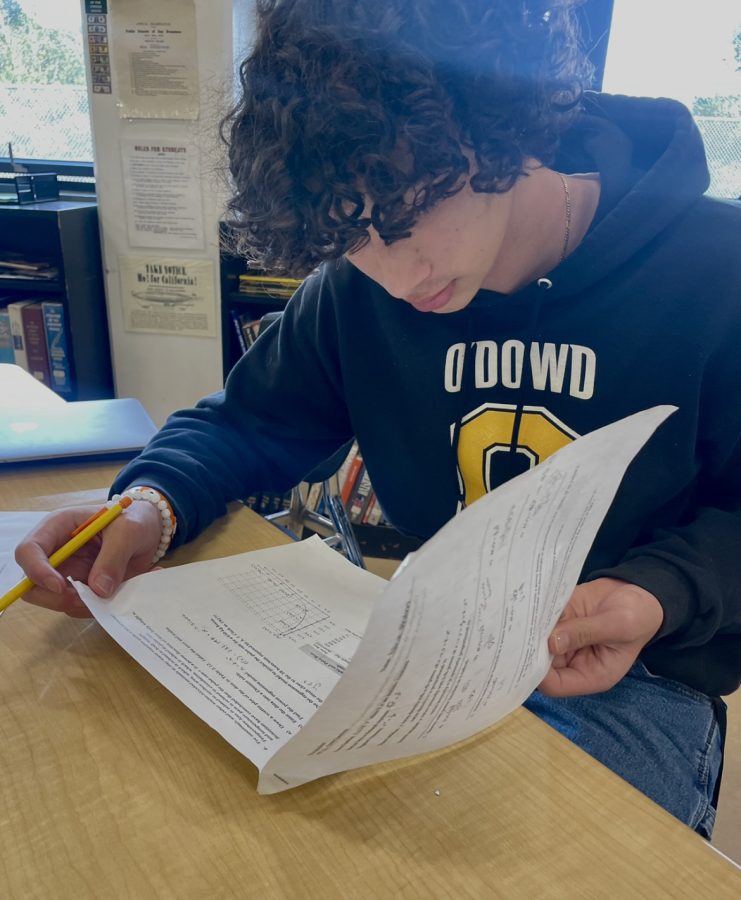Flipped Classroom: Fantastic or Flop?
A deep dive into the functionality and success of the flipped classroom
November 4, 2022
Math: a subject that is notorious for being confusing, yet just as rewarding to understand. But how do schools go about teaching this complex subject? Well, since online school, the math department at O’Dowd has implemented a style of teaching called the flipped classroom. A flipped classroom is defined as a style of teaching where students are instructed to take notes on the material before class, then complete their homework during class time. The idea is that teachers will do a review in class and aid the students with their homework, allowing the students to experience the lessons several times and therefore, improve their understanding. But the question remains, why did Bishop O’Dowd implement this teaching method?
When this question was posed to Ms. Firestone, a large figure in the math department, she clarified that this form of teaching was originally applied during Covid as a way for students to cut back on screen time. She stated, “lecturing on zoom is close to impossible,” which is a sentiment shared by many teachers and students. This reasoning is very sound and makes sense when applied to the schooling that occurred during the pandemic. However, beyond answering the question of why this format was originally implemented, how did the math department decide that this format would fit best? And what was the research behind this decision? In response, Ms. Firestone commented, “the research for it shows, with appropriate support and effective instruction to follow the flipping of the classroom… it can actually be very effective for student learning because they get to see the information twice and then they get to use it.” Coupled with this description, Ms. Firestone also stressed flipped classroom relies on the teacher’s in-class review and the “appropriate” and “effective” support that teachers provide. Without this, the teaching format will not aid the students in the intended way. When asked what the benefits of this method were, Ms. Firestone noted, “the benefits of it are that in person there is a facilitated collaboration and communication, a lighter load outside of the classroom, and then also you tend to review the information twice before working with it.” Nonetheless, it is important to consider what flipped classroom looks like in the classroom, especially since this was originally intended for zoom. In regards to why this method of teaching continued after the end of the online school, Ms. Firestone explained that this boiled down to what teachers preferred. At first, it was used create a smoother transition to in-person classes, but then the teachers who preferred to use it chose to proceed with the method, and those who didn’t went back to a fully traditional classroom. Based on the information Ms. Firestone provided, the math department clearly made an informed decision when implementing this format of teaching, however, the success of the method can only truly be measured through the students’ feedback.
Charlie Bonneville, ’23, and Scaru Esteva, ’25, relatively knew what a flipped classroom was, especially after a short explanation, however, they had very different opinions surrounding its functionality and the effect it had on their learning. Charlie stated, “I feel like in the past I’ve had a really hard time doing problem sets outside of school because I’ll think I understand it but then I get home and I look at the problems sets and my notes and I don’t understand what I’m doing. So it’s better for me to ask specific questions in class so I understand right then.” His statement encompasses the whole goal of flipped classroom: to prevent isolated struggling. However, when asked the same questions, Scaru had different responses, “flipped classroom does not help and it breaks away from going to a school because I am just teaching myself at home.” Scaru expressed very negative feelings and discussed a semester where the teaching method had been unhelpful. When specifically asked if flipped classroom had a positive effect on her learning she declared, “No, and it reflects on my grades.”
It is clear that the flipped classroom method has mixed reviews among the student body, attesting that all students have different learning needs which should be considered and addressed by teachers. The success of a classroom truly depends on the teacher and their ability to create an environment that supports and uplifts their students.


